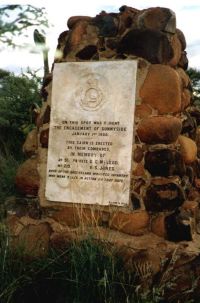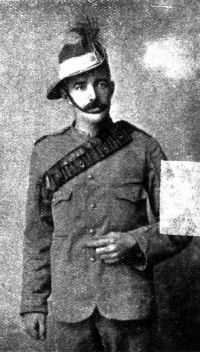Biography – Trooper Victor Stanlet Jones
Regimental No 219 'B' Company First (Queensland Mounted Infantry) Contingent
Victor Stanley Jones, was employed as the paymaster at the Mount Morgan Company, at the time of his enlistment in the Queensland Mounted Infantry. An athletic twenty-seven year old, he had for some time been connected with the mounted infantry and when the contingent was being formed obtained leave from his employment to volunteer for active service.
The contingent left on board the Cornwall on 1 November 1899 and arrived in Cape Town on 12 December, entraining to the Orange River. From there the contingent proceeded to Belmont, whence it took a prominent part in the engagement at Sunnyside on 1&nbap;January 1900.1
On the morning of 1 January a picket party consisting of Lieutenant Adie, Trooper Jones and four others were sent out to discover the line of the enemy's retreat. Frank Wilkinson, a war correspondent who was nearby reported –
Two reconnoitering patrols were detached from the Queensland Mounted Infantry to move around the east and west sides of the Sunnyside hills, with the idea of ascertaining exactly the position of the Boer laager. Unfortunately the western patrol, under Lieutenant Adie, after working round to the north-west corner of the broken ground above the laager, found itself too close to be comfortable, or even safe. The party was suddenly confronted by two Boers, about thirty yards from the rocky cover, afforded by the neighbouring kopje. Adie dismounted and called upon the pair to surrender, but just at this moment he and his men were fired upon by another lot of Boers, who were concealed among the rocks.2
Trooper Jones was shot through the heart and died instantly. His brother, G B Jones, writing to the Guild of Loyal Women of South Africa advised –
He was buried by a fellow trooper, on the veldt, far from any farm house, some twenty miles from Belmont. Trooper W Thomas, who laid Jones to rest with nought but his soldier's cloak around him, told us it was on the open veldt and there was little or nothing that he could do to mark the spot.3
He later wrote from Rockhampton to the Central Graves Committee of the Loyal Women of South Africa advising personal details about his late brother.
Victor was a fine young man, aged 27, 6ft in height, who at the first announcement of sending a Queensland contingent to South Africa gave up a good position, home and friends to fight for his Queen and country. He was afterwards destined to have the, to us, sad honor of being absolutely the first Australian to be killed in action in South Africa. This fact is certified to by his Captain, now resident in this city (Captain P W G Pinnock). Victor was in the scouting party of 4 men, under Lieutenant A G Adie, sent out on the morning of the Sunnyside engagement, and was shot dead on the veldt when his group were surprised by about 14 Boers.4
Charlotte S Sclater of the Guild of Loyal Women of South Africa wrote to the Jones family advising that the graves of Jones and McLeod were on the veldt far away from any farm house, about a mile apart from one another on the veldt.5 Jones stated in his letter that after the engagement at Sunnyside, the troops returned to Belmont and there erected a monument to his brother and Trooper David McLeod, who also died later on the same day. He requested that the Central Graves Committee attend to the erection of a simple headstone with stone kerbing and the following inscription –
In loving memory of
Trooper Victor S Jones Q M I
of
Rockhampton, Queensland
Killed January 1st 1900
Aged 27 years,
The first Australian
to fall in action in SA.6
The Loyalists at Douglas contributed £30/5/- towards the cost of erecting headstones over the graves of Jones and McLeod. As soon as hostilities ceased the Guild of Loyal Women of South Africa attended to the erection of the headstones. Lillian Orpen, the secretary of the Guild, requested that the remains of these two brave soldiers may be allowed to rest undisturbed in the graves where their comrades laid them.7
In his last letter Jones's brother advised that he was forwarding £10 towards the cost of the headstone and also expressed the desire that his brothers remains be left where he was buried on the veldt.8
Despite the requests of the Jones's family and the members of the Guild, the remains of both Jones and McLeod were moved to the Garden of Remembrance, West End Cemetery, in Kimberley.

Sunnyside Monument to VS Jones & DC McLeod, first Australian soldiers killed in the War
(Trish Woodman)
1 Official records of the Australian military contingents to the war in South Africa / compiled and edited for the Department of Defence by P.L. Murray, Melbourne : A.J. Mullett, Govt. Printer, 1911
2 Australia at the Front – A Colonial View of the Boer War, Frank Wilkinson, London, 1901.>.
3 Letter from G B Jones, Rockhampton to the Secretary, Central Graves Committee, Guild of Loyal Women, Kenilworth, dated 20 November 1901. National Archives of Australia, Melbourne, Series MP 744/1 Item 4611/MIS. A contradictory statement appeared in the Town and Country Journal, 10 February 1900, which stated that a rude cross was erected over the grave.
4 Ibid.
5 Letter from Charlotte S Sclater of the Guild of Loyal Women of South Africa, Kenilworth to His Excellency, the Governor of Queensland, National Archives of Australia, Melbourne, dated 27 September 1901. Series MP 744/1 Item 4611/MIS.
6 Letter from G B Jones, Rockhampton to the Secretary, Central Graves Committee, Guild of Loyal Women, Kenilworth, dated 20 November 1901. National Archives of Australia, Melbourne, Series MP 744/1 Item 4611/MIS
7 Letter from Lillian Orpen, Secretary, Guild of Loyal Women of South Africa, Douglas to the Officer Commanding, Queensland Mounted Infantry dated 10 September 1902. National Archives of Australia, Melbourne, Series MP 744/1 Item 4611/MIS.
8 Letter from G B Jones, Rockhampton to the Under Secretary, Chief Secretary's Office, Brisbane, dated 5 December 1902. National Archives of Australia, Melbourne, Series MP 744/1 Item 4611/MIS



